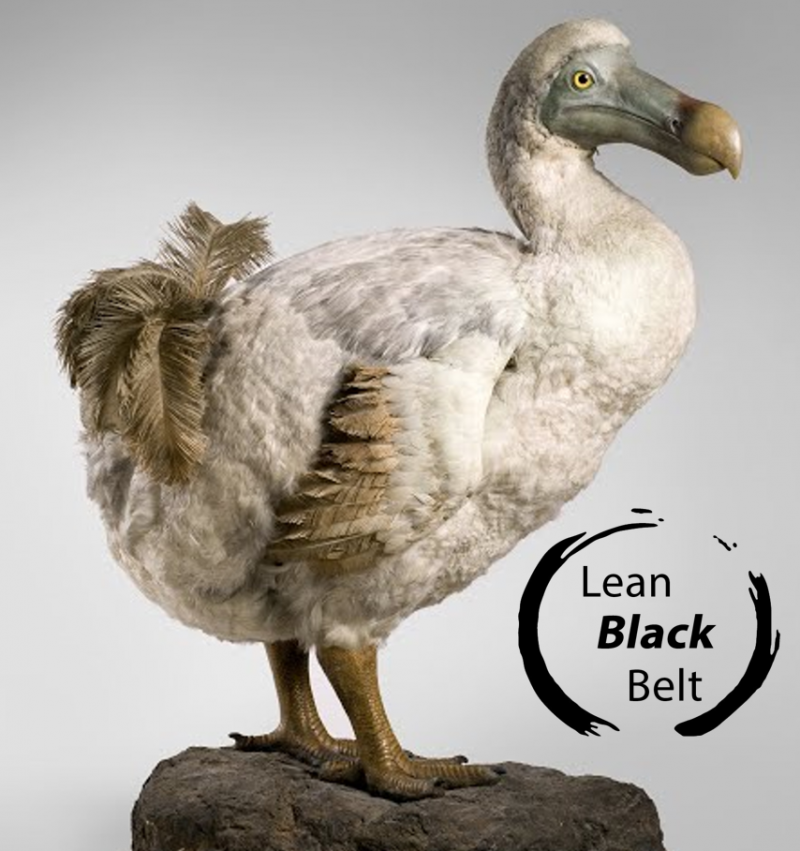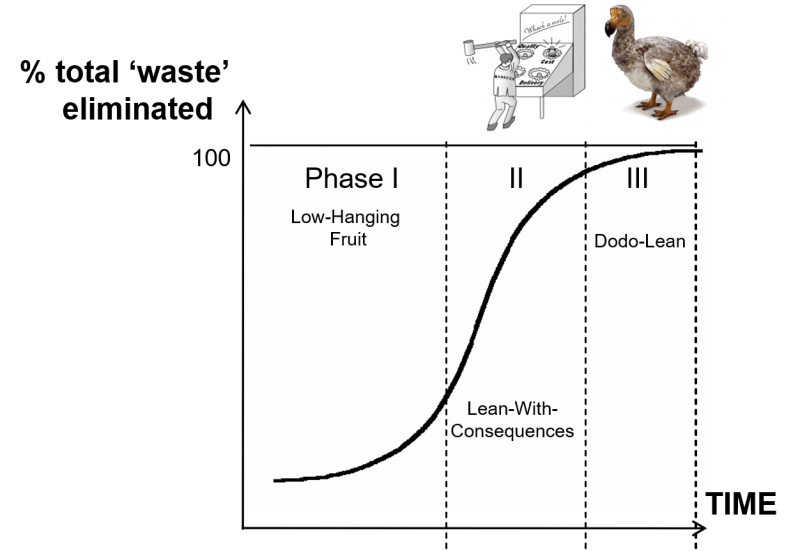
I’m fortunate to be invited to lecture on a number of Lean programmes. My usual job is to provoke Lean professionals so that they’re able to recognise when it is appropriate to deploy lean-thinking, and when it is not. The main times it is not appropriate is when systems find themselves at the top of the S-curve. Top of the S-curve means that a system has hit a fundamental limit and as such ‘optimization’-based improvement techniques won’t work any more.
For the most part, my words, I’m sure, fall on deaf ears. Especially when I suggest that, thanks to several decades of lean-thinking and continuous-improvement activity, nearly every enterprise on the planet finds itself sitting at the top of an S-curve.
About ten years ago we started to identify three different phases of Lean. The first phase is what we called the ‘Low-Hanging Fruit’ Phase. This is the time when it is relatively easy to find examples of waste inside an organisation. And, when we take steps to eliminate that waste, there are no adverse consequences. The waste was genuine waste.
The second phase starts when attempts to eliminate waste begin to deliver unexpected adverse consequences. This is what might be thought of as the Whack-a-Mole or ‘Lean-With-Consequences’ Phase. This is the period when Lean improvement professionals increasingly find themselves spinning around in circles, gradually realising that every time they think they’ve solved one problem, another one pops up.

Then, finally, there is the third ‘Dodo’ Phase. This is the phase where so much ‘waste’ has been stripped from the system that it is unable to react when the outside world changes. As happened with the now-extinct Dodo.
In nature we see the evolutionary pressures of ‘survival of the fittest’ favour systems that waste less than those around them. But natural systems that optimize themselves too much tend to be the ones that become extinct. The Dodo offering us an iconic example. In its original environment, since most of the Dodo’s food was found on the ground in jungle-like environments, the ability to fly was not nearly so advantageous as having big thigh muscles that allowed the bird to run. Hence, over time, birds with smaller wings and larger thighs were more likely to thrive than those with big wings and small thighs. Putting evolutionary energy into flight-worthy wings was ‘wasteful’ from an evolutionary perspective, and so there came a point where the Dodo was no longer able to fly. Evolution favoured birds that ‘spent’ their available resources on thigh muscles. This is efficiency at work. Stop ‘wasting’ resources on wings. Fine until a predator appears that is able to run (and shoot!) much faster than the bird is able to do. At this point, the ability to fly would have been really useful. Sadly, it wasn’t possible for the Dodo to ‘re-evolve’ wings fast enough to avoid complete extinction.
A lot of the time, the clients that kindly call us in to help are at the second, ‘Lean-With-Consequences’ Phase. TRIZ is the perfect tool for helping in this kind of situation since the ‘adverse consequences’ arising from an attempted improvement action are, in TRIZ terms, merely the contradiction that needs to be addressed. And resolved.
Maybe our high level of exposure to Phase Two enterprises over the years has been something of a self-fulflling prophecy? Whatever the (probably unknowable) truth, my view of the world was that there were a lot more Lean-With-Consequences enterprises than there were Phase Three, Dodo-Lean enterprises. Now, sitting at the beginnings of the global crisis triggered by Covid-19, and watching share prices plummet, ruthless companies sacking staff and should-know-better large multi-nationals begging governments for handouts, I’m beginning to realise my instincts were all wrong. What we’re all watching right now is a world chock-full of Dodo Lean.
On some level, it often requires this kind of crisis to trigger enterprises into meaningful action. Indeed, we’re already seeing just how creative people can be when they find themselves confronted with rules that don’t apply anymore. In that regard, I’m kind of hopeful that many of the Dodos will be able to re-evolve wings and, to mix the avian metaphors, rise from the ashes (I’d certainly be happy to offer my services to see how we might help prove it). On the other hand, I’m also seeing what we’ve been saying for several years right now, an almost complete absence of crisis-solving creativity at the top of these Dodo-Lean companies. So- called leaders that, for the most part, find it easier to send out redundancy letters to half their staff rather than engage their brains and do what everyone with actual skin-in-the-game at the frontline knows to do: get stuck in, survive, thrive.
We know who you are. Another great thing about crises: its almost impossible to hide. There is no more hiding beneath the parapet. These people need to do the honourable thing and get out of the way. Hand over to people with grit, persistence and a belief that what doesn’t kill you will, in business at least, make you stronger. Step up, or step away.
